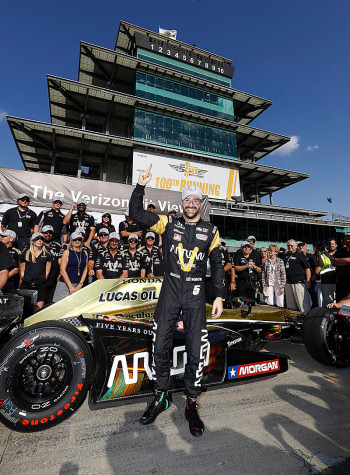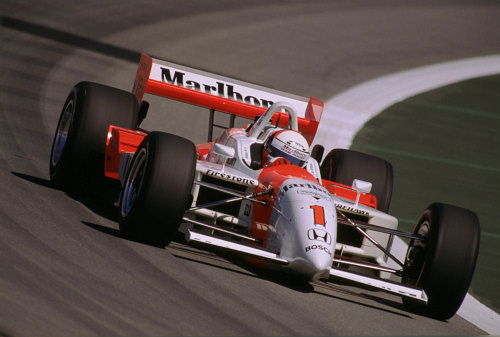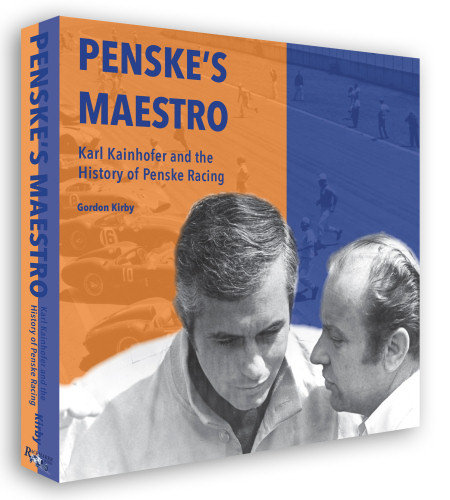The Way It Is/ White knuckles at the Speedwayby Gordon Kirby |
 James Hinchcliffe, Schmidt-Peterson Motorsports and Honda did a superb job to take the pole for this year's 100th Indy 500. Hinchcliffe was one of the fastest drivers all week and he set the pace on both Saturday and Sunday as he completed a magnificent comeback from the grievous injuries he suffered at the Speedway twelve months ago.
James Hinchcliffe, Schmidt-Peterson Motorsports and Honda did a superb job to take the pole for this year's 100th Indy 500. Hinchcliffe was one of the fastest drivers all week and he set the pace on both Saturday and Sunday as he completed a magnificent comeback from the grievous injuries he suffered at the Speedway twelve months ago.
Fine work was also turned in last weekend by Josef Newgarden and Ryan Hunter-Reay who seriously challenged Hinchcliffe as they qualified second and third. Without doubt, having one Canadian and two Americans on the front row for this year's 500 is a good thing. But it was sad listening to many of the drivers talking about their struggles to hang onto their ill-handling cars in qualifying. Clearly, most of them are not fans of the infamous 'domed skids' added to the bottom of the cars to try to prevent them flying.  © Mike Levitt, LAT USA "It's been really tough to drive the car. I think the dome skid is adding a lot to that. We could make the car comfortable to drive, but when you trim the thing out and try to go as fast as possible, it gets uncomfortable. It always does but it seems a little bit more uncomfortable this year with the dome skid. A lot of that is the way the car works in the wind. It's not as stable in the wind. I think everyone had their hands full today. "On a day like today, I'm white-knuckling the thing. I'm as tense as can be. I'm alert to every little movement in the car. You're just clenching, just hoping the thing is not going to go away from you and hit the wall." Other drivers had similar words: "It's pretty miserable out there," Scott Dixon said. "We struggled to hold it together." Commented Graham Rahal. "You're trying to muscle this thing into the corner at 230 mph in the wind and it's not fun." Graham's father Bobby was almost apoplectic about both the adverse effects of the domed skids and the infernally complex qualifying system in place at the Speedway this year. Many, many people agreed with Bobby. In sharp contrast to the unhappy story for many at the Speedway this year, Arie Luyendyk and Gil de Ferran have frequently raved about the superb handling of their CART-specification cars from twenty years ago. Luyendyk set the track record at Indianapolis in 1996 averaging 236.986 mph over four qualifying laps that took him 2 minutes 31.908 seconds. Three years later amid the final years of CART's big horsepower turbo engines de Ferran turned the fastest lap ever achieved on a closed circuit or track in qualifying for CART's 2000 season finale at the high-banked, 2.0-mile California Speedway. De Ferran qualified on pole for the California 500 aboard one of Penske's Reynard-Hondas at 241.428 mph, scorching around the track in 30.255 secs.  © Paul Webb/Racemaker Press "I should have been on the pole and won the race that year because we had the fastest car," Luyendyk recalls. "It was the best car I ever drove at the Speedway as far as the way it handled. It didn't scrub off any speed. That was the year they repaved the track and took out the rumble strips. We also had an unbelievable tire and it all came together. "The only thing I needed was more horsepower to go quick. I could do 238 at pretty much any time. It all depended on the weather, but the stars weren't aligned. Somebody hit the wall in the morning practice and we had to change the engine in my car. I got in the back-up car and it wasn't set up like the other one. They didn't weigh it so we were seven pounds too light. So I came back on Sunday in the primary car and set the record. But I would have enjoyed winning the 500 all day long rather than having the record." Unfortunately, Luyendyk ran into trouble in the race and eventually dropped out after his car was damaged in a multi-car accident. De Ferran was racing for the championship in California in 2000 and his primary goal when he set his world record was earning an additional point for pole position to help him his championship battle with Adrian Fernandez. "We were regularly running above 239-240 mph in practice and I think I had a lap at 242 at one point, helped by a tow," de Ferran recalls. "When I went out to qualify they finally put the qualifying map on the engine, which was a little bit extra. The thing was a rocket ship and without the turbulence from the other cars to disturb the car and provide a tow the car was just stuck on the ground.  © Racemaker Press "But when I did that 241 qualifying lap the car was just perfect. I remember feeling everything through my hands. Especially going into turn I was telling myself, 'Don't lift! Don't lift!' You've just gotta believe in the car because on a big oval if you wait to feel that the grip is there, then it's too late. So there is a big commitment factor in oval driving. You've got to throw yourself in there, particularly in qualifying, because the grip changes with the air temperature and humidity. "I think it was pretty cool that we were able to make that record under racing conditions," de Ferran adds. "A lot of record attempts are done in special conditions away from a race weekend. As far as accomplishments go, that is one I'm very proud of." Motor racing is supposed to be about improving the breed, but over the past twenty years Indy car racing has gone irrefutably backwards both technically and in it's appeal to the public and media. The current formula also places the drivers at additional risk, making the sport more dangerous rather than safer. All of Indy car racing's great drivers--Rick Mears, Mario Andretti, A.J. Foyt, Parnelli Jones, Bobby & Al Unser, et al--have said repeatedly that the current formula needs to be drastically changed with more power and less downforce. To most everyone in the sport, past and present, this is a no-brainer. Yet IndyCar has added downforce to the equation, courtesy Chevrolet and Honda's hideously unattractive aero kits as they've applied band-aid after band-aid to a very bad concept. The powers-that-be at IndyCar have stuck their heads in the sand and are entirely resistant to change. As Chip Ganassi's general manager Mike Hull said in this space last month, a revolution is required, but with American's Indy car-building industry destroyed and Dallara left as the only likely car builder, any such transformation looks impossible.  © Racemaker Press In closing, I want to invite readers who are in Indianapolis this week to the launch of two new Racemaker Press books: 'Penske's Maestro, Karl Kainhofer and the History of Penske Racing' and 'Tony Bettenhausen & Sons, An American Racing Family Album'. My publisher Joe Freeman and I will unveil these books at the IMS's Hall of Fame Museum on Friday evening May 27 between 6-8 mph. Karl Kainhofer and Merle Bettenhauen will be on hand to sign books for you. 'Penske's Maestro' is a large format, hardbound 360-page book with over 400 photos and a complete listing of Karl's racing record. Over 42 years from 1958-1997 Kainhofer's cars and engines won a remarkable 170 of 535 races. I interviewed more than 50 people--drivers, mechanics, fabricators, engine builders, etc--who worked with Karl over the years and I'm pleased to report that the book tells not only Karl's story but also the real human history of Penske Racing. 'Tony Bettenhausen & Sons' is a similar large format, hardbound book filling 225 pages with more than 300 photos. This is primarily a family photo album covering the lives and careers of Tony Bettenhausen and his three sons Gary, Merle and Tony Jr. Merle and his sister Susan have helped bring two-time Indy car champion Tony Sr. to life as well as portraying the life and times of the sport through the post-WWII era. This is a very warm, personal book about one of America's greatest racing families. Following our Friday evening launch of these two books we will also sell books at the Racemaker Press booth at the IMS's Memorabilia Show on Saturday, May 28th. 'Penske's Maestro' retails for $89.95 and 'Tony Bettenhausen & Sons' sells for $59.95. If you're not in Indianapolis this week you can order the books from racemaker.com or call (617) 723-6533. |
|
Auto Racing ~ Gordon Kirby
Copyright ~ All Rights Reserved |
